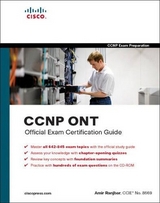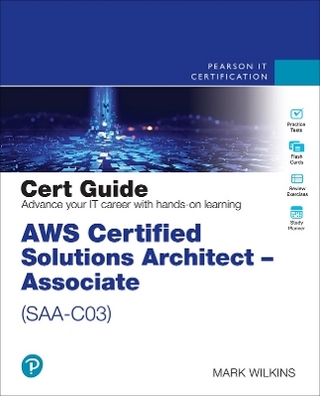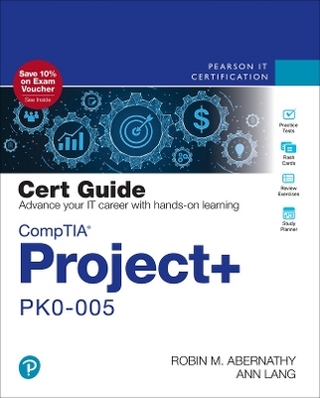
CCNP CIT Exam Certification Guide (CCNP Self-Study, 642-831)
Cisco Press
978-1-58720-081-6 (ISBN)
- Titel erscheint in neuer Auflage
- Artikel merken
Prepare for the new CCNP 642-831 CIT Exam with the official test preparation guide
Learn the troubleshooting and support topics for the new Cisco CCNP 642-831 CIT exam with the only official preparation book
Practice with more than 200 test questions, including simulation-based questions on the enclosed CD-ROM
Prepare for the CCNP CIT exam with proven learning tools from the No. 1 selling Exam Certification Guide Series from Cisco Press
CCNP CIT Exam Certification Guide (CCNP Self-Study) is a comprehensive study tool for preparing for the new CCNP 642-831 CIT exam. This book is the second edition of the best-selling preparation title for the CCNP CIT exam from Cisco Press, also authored by Amir Ranjbar.
Comprehensive coverage of all exam topics ensures readers will arrive at a complete understanding of what they need to master to succeed on the exam. This book follows a logical organization of the CCNP CIT exam objectives, and is written in a modular, small-chapter format that breaks the elements into easy-to-absorb parts. It also contains the other valuable learning elements of an Exam Certification Guide from Cisco Press that ensure concept comprehension and retention. These include pre- and post-chapter quizzes, foundational review sections, scenario-based exercises, and a CD-ROM testing engine with more than 200 questions, including simulation-based questions like on the actual exam.
The organization of this edition has been radically altered to align with the new CIT objectives that focus on troubleshooting methodologies to resolve problems at the Physical, Data Link, Network, Transport, and Application layers of the OSI Model.
Amir Ranjbar, CCIE No. 8669, is an instructor and senior network architect for Global Knowledge. He is a certified Cisco Systems instructor and has a Bachelor's degree in Computing and Information Science and a Master's Degree in Knowledge Based Systems from the University of Guelph in Ontario, Canada. Amir is the author of the first edition of the CCNP Support Exam Certification Guide from Cisco Press.
Introduction.
I. ESTABLISHING A BASELINE.
1. Creating Network Configuration Documentation.
“Do I Know This Already?” Quiz. Foundation Topics. Components of a Network Configuration Table. Components of a Topology Diagram. Discovering Network Configuration Information. The Process of Creating Network Documentation. Guidelines for Creating Network Documentation. Foundation Summary. Q&A.
2. Creating End System Network Configuration Documentation.
“Do I Know This Already?” Quiz. Foundation Topics. Components of an End System Network Configuration Table. Components of an End System Network Topology Diagram. Commands and Applications Used to Gather Information about End System Network Configurations. Discovering End System Network Configuration Information. Creating End System Network Configuration Documentation. Foundation Summary. Q&A.
II. DETERMINING AN EFFECTIVE TROUBLESHOOTING STRATEGY.
3. Applying a Logical Layered Model to a Physical Network.
“Do I Know This Already?” Quiz. Foundation Topics. The Encapsulated Data Flow Process. Comparing Layered Networking Models. The Layers of a Logical Model. Foundation Summary. Q&A.
4. The General Troubleshooting Process.
“Do I Know This Already?” Quiz. Foundation Topics. The General Troubleshooting Process. The Gather Symptoms Stage. The Isolate the Problem Stage. The Correct the Problem Stage. Foundation Summary. Q&A.
5. Gathering Symptoms.
“Do I Know This Already?” Quiz. Foundation Topics. Gathering Network Symptoms. Gathering User Symptoms. Gathering End System Symptoms. Foundation Summary. Q&A.
6. Selecting a Troubleshooting Approach.
“Do I Know This Already?” Quiz. Foundation Topics. The Bottom-Up Troubleshooting Approach. The Top-Down Troubleshooting Approach. The Divide-and-Conquer Troubleshooting Approach. Selecting a Troubleshooting Approach. Foundation Summary. Q&A.
III. RESOLVING PROBLEMS AT THE PHYSICAL AND DATA LINK LAYERS.
7. Isolating a Problem at the Physical or Data Link Layer.
“Do I Know This Already?” Quiz. Foundation Topics. Identifying the Symptoms of Problems Occurring at the Physical Layer. Identifying the Symptoms of Problems Occurring at the Data Link Layer. Analyzing Commands and Applications Used to Isolate Problems Occurring at the Physical and Data Link Layers. Guidelines for Isolating a Physical or Data Link Problem. Foundation Summary. Q&A.
8. Correcting a Problem at the Physical or Data Link Layer.
“Do I Know This Already?” Quiz. Foundation Topics. Commands and Applications Used to Correct Problems Occurring at the Physical and Data Link Layers. Physical and Data Link Layer Support Resources. Correcting a Physical or Data Link Layer Problem. Foundation Summary. Q&A.
IV. RESOLVING PROBLEMS AT THE NETWORK LAYER.
9. Isolating a Problem at the Network Layer.
“Do I Know This Already?” Quiz. Foundation Topics. The Symptoms of Problems Occurring at the Network Layer. End System Commands and Applications Used to Isolate Problems Occurring at the. Network Layer. Analyzing Cisco Command and Application Output to Isolate Problems Occurring at the Network Layer. Isolating a Problem Occurring at the Network Layer. Foundation Summary. Q&A.
10. Correcting a Problem at the Network Layer.
“Do I Know This Already?” Quiz. Foundation Topics. Cisco Commands Used to Correct Problems Occurring at the Network Layer. End System Commands and Applications Used to Correct Problems Occurring at the Network Layer. Examples That Demonstrate Correction of Network Layer Problems. Network Layer Support Resources. Correcting Problems Occurring at the Network Layer. Foundation Summary. Q&A.
V. RESOLVING PROBLEMS AT THE TRANSPORT AND APPLICATION LAYERS.
11. Isolating a Problem at the Transport or Application Layer.
“Do I Know This Already?” Quiz. Foundation Topics. Symptoms of Problems Occurring at the Transport Layer. Symptoms of Problems Occurring at the Application Layer. Commands and Applications Used to Isolate Problems Occurring at the Transport Layer. Commands and Applications Used to Isolate Problems Occurring at the Application Layer. Guidelines for Isolating a Problem Occurring at the Transport or Application Layer. Foundation Summary. Q&A.
12. Correcting a Problem at the Transport or Application Layer.
“Do I Know This Already?” Quiz. Foundation Topics. Identifying Commands and Applications Used to Correct Problems Occurring at the Transport Layer. Identifying Commands and Applications Used to Correct Problems Occurring at the Application Layer. Identifying Transport and Application Layer Support Resources. Correcting Problems Occurring at the Transport and Application Layers. Foundation Summary. Q&A.
VI. SCENARIOS.
13. CIT Scenarios and Examples.
Network Documentation. Gathering Symptoms. Resolving Problems at the Physical or Data Link Layer. Resolving Problems at the Network Layer. Resolving Problems at the Transport and Application Layers.
VII. APPENDIX.
Appendix A: Answers to the “Do I Know This Already?” Quizzes and “Q&A” Sections.
Glossary.
Index.
| Erscheint lt. Verlag | 4.12.2003 |
|---|---|
| Reihe/Serie | CCNP Self-Study |
| Verlagsort | Indianapolis |
| Sprache | englisch |
| Maße | 195 x 239 mm |
| Gewicht | 804 g |
| Themenwelt | Mathematik / Informatik ► Informatik ► Netzwerke |
| Informatik ► Weitere Themen ► Zertifizierung | |
| ISBN-10 | 1-58720-081-3 / 1587200813 |
| ISBN-13 | 978-1-58720-081-6 / 9781587200816 |
| Zustand | Neuware |
| Haben Sie eine Frage zum Produkt? |
aus dem Bereich



